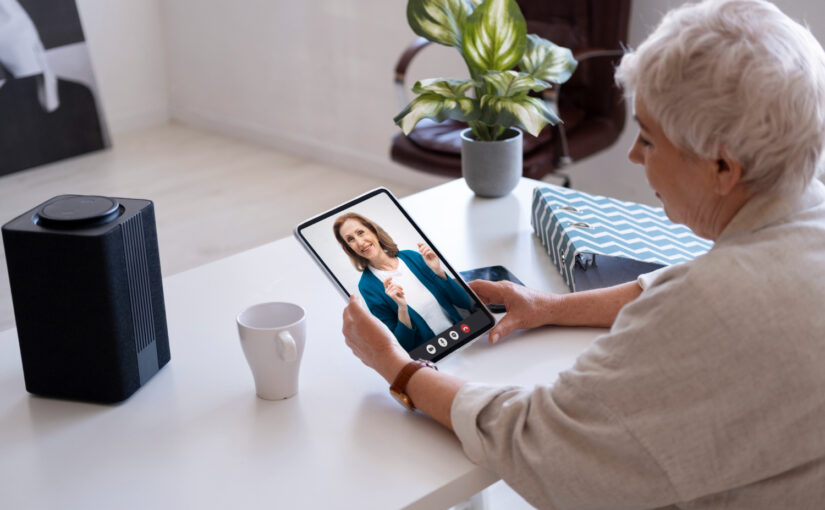
 LEAVE A COMMENT
LEAVE A COMMENTHealthcare and senior care living are being significantly impacted by the ongoing advancements in technology. In an effort to improve their everyday lives, older individuals are embracing and using technology at an increasing rate. Technology in senior living facilities has many advantages that enhance the standard of care and general wellbeing of the residents.
Acceptance of Technology by Seniors
In recent years, there has been a notable surge in older persons’ use of technology. With 83% of people between the ages of 50 and 64 and 61% of people 65 and beyond possessing a smartphone in 2024, the proportion of older persons who own a smartphone has significantly increased. Furthermore, 90% of senior citizens utilize the internet and own a laptop or computer.
Seniors’ increased use of technology has created new opportunities for interaction with online communities that support lifestyle modifications and illness self-management. More commonly than younger patients, older folks are actively using digital coaching platforms to enhance their health.
Older individuals can now more easily get the support and assistance they require to lead happier and healthier lives thanks to the growing use of technology.
How Technology Helps in Senior Living Homes
Telehealth and Remote Care
Telehealth and remote care have become important elements of contemporary healthcare as technology develops, especially in enhancing assisted living and healthcare. The advantages of remote patient monitoring and the expanded availability of healthcare services are examined in this section.
Better Access to Healthcare Services
Seniors now have more access to medical treatment because to telehealth services, which have completely changed the way healthcare is provided. The number of older persons who had telemedicine encounters with their healthcare providers increased dramatically, particularly during the COVID-19 pandemic. Just 4.6% of older persons visited a telehealth provider before the outbreak. But during the epidemic, this percentage increased to 21.1%, demonstrating how seniors are increasingly accepting and using telehealth services.
Seniors can now receive medical care remotely in assisted living homes thanks to telehealth services, which do away with the necessity for in-person appointments. Older folks who may have mobility issues or reside in remote places with little access to medical services would especially benefit from this. Seniors can communicate with their healthcare doctors via secure texting, phone calls, or video consultations by utilizing telehealth technologies. Seniors can get prompt medical advice and treatment without needless travel or personal touch because to its accessibility and convenience.
Remote Patient Monitoring
Remote patient monitoring is a key component of telehealth and remote treatment. With the use of this technology, medical professionals may keep an eye on their patients’ health from a distance, offering ongoing treatment and prompt intervention as needed. Wearable technology and smart home systems are examples of remote patient monitoring devices that gather and send critical health data to medical specialists, enabling them to proactively monitor the health condition of elders.
Vital signs, activity levels, sleep habits, and even fall detection can all be tracked by wearable technology, such smart watches. These gadgets give medical professionals useful real-time data that helps them quickly identify any changes or possible health problems. Furthermore, voice-activated assistants and sensors in smart home systems can track daily activities, medication compliance, and even identify emergencies like falls or accidents.
EHR AND SENIOR HEALTH
Electronic health records (EHRs) are another way that technology is enhancing senior healthcare. Real-time access to a patient’s medical history and data is made possible by electronic health records (EHRs), which can enhance the standard of care. Seniors no longer have to remember all of their prescriptions or bring around paper records thanks to this. Additionally, EHRs facilitate communication and collaboration among physicians, which may improve patient outcomes.
COMMUNICATION TECHNOLOGY
Seniors are increasingly using technology to maintain relationships with their loved ones. For instance, family members who reside far away can be virtually visited via video conferencing services like Zoom and Skype. In addition to sharing updates and pictures, social media sites like Facebook and Instagram may be used to maintain relationships with loved ones. In summary, technology is enhancing healthcare and senior life in a number of ways. Seniors can live more independently and receive better care thanks to technology, which includes telemedicine and virtual reality therapy. Smart home technology, telemedicine, and electronic health records also make it simpler for medical professionals to offer seniors with high-quality care. We may anticipate seeing even more ways that technology can enhance senior citizens’ life in senior care living as it develops further.